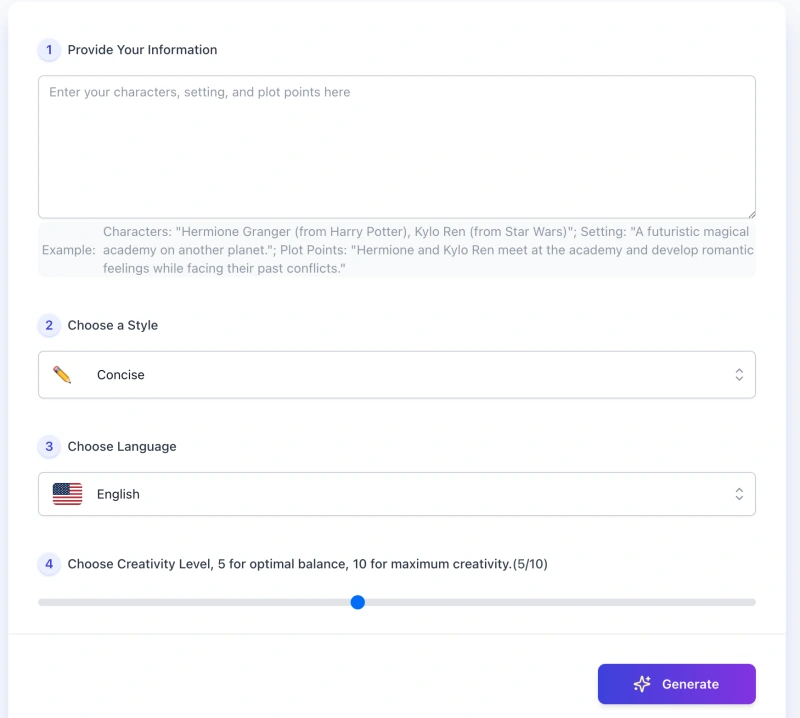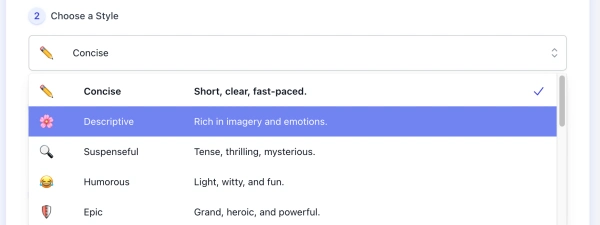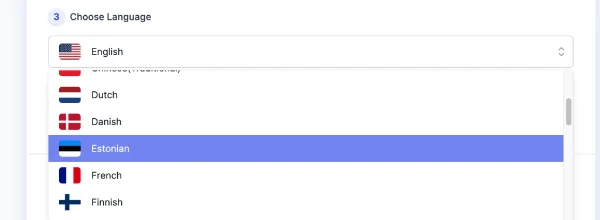Free AI Tools. No Sign-Up Required. Full Access.
AI Fanfic Maker
Free AI Fanfiction Generator to write creative fanfiction — no sign-up, perfect for fans, writers, and storytellers who love reimagining worlds.
Combine the current tool with these other tools to work more efficiently.
Discover other tools with functions and purposes similar to the one you are currently viewing.
Discover the tools most favored and highly-rated by users on our website.
Explore more AI tools in these related categories
AI tools for generating, and assisting with story and book writing tasks.
AI Writing tools generate, or enhance text content for various writing tasks.
AI tools that generate, brainstorm, or enhance creative concepts, ideas, and inspiration.
This is the AIFreeBox AI Fanfic Maker page —designed to help fanfiction writers spark new plot ideas and overcome creative blocks. Support Free & Ultra plan!
On this page, you’ll find a complete guide to what this fanfiction generator does, where it’s useful, how to use it effectively, tips to shape better stories, limitations you might encounter, and solutions to common issues. A detailed FAQ section is also included.
What is Fan fiction?
Fan fiction refers to stories written by fans that expand upon the worlds and characters of existing books, movies, TV shows, or video games. It allows fans to explore alternative plots, character relationships, and new settings, offering endless creative possibilities. Yet, coming up with fresh ideas or writing detailed narratives can be challenging, especially when dealing with writer’s block or time constraints.
What Can AIFreeBox AI Fanfic Maker Do?
Built on a custom language engine, the AI Fanfic Maker processes your input—characters, settings, and plot points—and helps shape story ideas when inspiration stalls. It draws on large-scale narrative patterns, having been fine-tuned on millions of publicly available story texts with strong narrative structure to optimize its ability in plot construction and character interaction, serving as the perfect AI fanfic writer companion.
This tool isn’t built for churning out generic stories—it’s designed to assist real writers with structure, tone, and inspiration. With support for over 33 languages and 25+ writing styles, it adapts to your creative direction, not the other way around.
🆚 AI Fanfic Generator vs. Generic Text Rewriter
Unlike generic rewriting tools, this fanfic-specific generator is built to support original storytelling—not just rearrange existing words.
| 🔍 Feature | 🌀 Generic Rewriter | 🪄 AI Fanfic Generator |
|---|---|---|
| 🎭 Purpose | Rephrases or simplifies existing text | Creates original fanfiction based on your inputs |
| 🧠 Input Understanding | Limited context awareness | Understands characters, setting, and plot direction |
| 💬 Dialogue Creation | Rarely includes or misrepresents character voices | Generates natural dialogue true to fanfic tone |
| 🎨 Style Control | Little or no style differentiation | Supports 14 narrative styles (e.g. Romantic, Suspenseful) |
| 📚 Story Structure | No narrative arc | Provides beginning, middle, and end with emotional depth |
| 🌍 Fandom Relevance | Generic or unrelated to fan universes | Supports crossovers, AUs, and fandom-specific context |
| 🧩 Creative Control | One-off static output | Offers alternate storylines and twist suggestions |
| 🌐 Language & Tone | Basic grammar-level rewording | Supports 33+ languages and 25+ tone styles |
Common Use Cases and Who It’s For
| Use Case | Pain Point Solved | Who It’s For |
|---|---|---|
| Writer’s block | Provides story ideas when you’re stuck | Fanfic writers lacking inspiration |
| Starting a new fanfic | Helps outline characters, setting, and initial plot | Writers planning a new series or one-shot |
| Cross-universe pairings | Generates plausible scenarios across fandoms | Writers exploring crossover ships or AU settings |
| Developing character dynamics | Suggests emotional arcs and tension-building moments | Writers building slow burns, rivals-to-lovers, etc. |
| Writing in different tones or moods | Adapts to 25+ narrative styles | Writers experimenting with tone, genre, or POV |
| Writing in other languages | Supports over 33 languages | Multilingual fanfiction writers or global audiences |
| Finishing an incomplete story | Suggests continuation ideas based on prompts | Writers revisiting drafts or unfinished WIPs |
| Practicing narrative structure | Offers coherent, structured drafts to learn from | New writers learning story construction |
Step-by-Step Guide: How to Use AI Fanfic Creator

1. Provide Your Story Information
In the first input box, describe the basics of your fanfic idea. This can include:
- Characters (e.g., “Hermione Granger, Kylo Ren”)
- Setting (e.g., “a futuristic magical academy on another planet”)
- Plot Points (e.g., “they meet at the academy and confront their past”)
This step helps the AI understand the context of your story. The more specific you are, the more focused the output will be.
2. Choose a Writing Style

Select one of 14 available narrative styles that best suits your tone or genre. Options include Romantic, Gothic, Humorous, Suspenseful, and more. Each style adjusts the pacing, emotion, and voice to better match your intent.
3. Choose the Language

Pick your preferred writing language. The tool supports over 33 languages, allowing you to write in your native tongue or explore fanfiction across cultures.
4. Set Creativity Level
Use the slider to adjust how creative or grounded the output should be:
- 5 for balanced structure and coherence
- 10 for maximum imagination and unexpected ideas
Try different levels to explore new storytelling directions.
5. Click “Generate”
Once all fields are set, click the Generate button. The tool will create a draft fanfic based on your input. You can revise, edit, or regenerate to refine the results.
6.Report Bug or Feedback (Real Human Support)

If you encounter any issues, use the Report Bug button. Your feedback goes directly to our support team, where real people are available to review and resolve problems quickly. This ensures a reliable experience and shows our commitment to user support.
Remember, the generated story is just a starting point—an early draft to spark your creativity. To make your fanfic truly engaging and emotionally rich, treat the output as inspiration and continue shaping it with your own voice, ideas, and edits.
Effectively Use It for Good Fanfic: Tips
- Be specific with your inputs. The more clearly you define characters, setting, and emotional tone, the more aligned the output will be with your vision.
- Use the creativity slider intentionally. A middle range (5–7) works best for structured storytelling. Higher levels (8–10) can produce more surprising or abstract narratives—ideal for experimental stories.
- Choose a style that reflects your story’s core mood. If you’re writing something reflective or romantic, match the tone early to avoid mismatched outputs.
- Edit the output like a first draft. Treat it as a base. Add details, adjust dialogue using this Writer’s Dialogue Tool, refine pacing—this is where your voice and emotion come in.
- Don’t hesitate to regenerate. If the output feels off, tweak your inputs or try a different creativity level. Iteration often leads to better results.
- Focus on emotional clarity. AI can offer plot structure, but it’s up to you to deepen relationships, conflicts, and emotional stakes.
Example: From Prompt to Story Draft
Input Prompt
Characters: Hermione Granger (Harry Potter), Kylo Ren (Star Wars)
Setting: A futuristic magical academy on another planet
Plot Points: They meet at the academy and develop a complex bond while confronting their personal traumas
Generated Output (Excerpt)
Hermione stepped into the crystal-lit corridor, her wand humming with faint energy. Kylo was already there, leaning against the archway, his eyes shadowed but steady. “You’re late,” he said, voice low. She met his gaze without flinching. “Or you’re just early.”
In this academy where time bent and rules faded, their worlds collided—not with spells, but with silence. They had both seen war, and something unspoken lingered between them: a recognition, sharp and heavy.
How to Revise It
- Expand character voice: Add more internal thoughts to reflect Hermione’s emotional state and Kylo’s hidden conflicts.
- Adjust pacing: Slow down the moment of first contact to build more tension and anticipation.
- Insert personal symbolism: Include magical elements or gestures that reflect their inner transformation (e.g., Hermione’s wand reacting to emotions).
- Deepen emotional stakes: Highlight what’s at risk for each character as they start to trust one another.
This kind of revision process turns a functional draft into something meaningful—grounded in your characters, your story arc, and your voice. AI helps set the stage, but emotional impact comes from how you shape the scene.
Writing Style Options: What Each One Means
- ✏️ Concise — Short and fast-paced, perfect for quick reads or scenes that get to the point.
- 🌸 Descriptive — Rich in detail and emotion, ideal for painting vivid settings and inner thoughts.
- 🔍 Suspenseful — Builds tension and mystery, great for thrillers or slow-reveal plots.
- 😂 Humorous — Light and witty, great for parody, banter, or feel-good stories.
- 🛡️ Epic — Heroic and grand, perfect for battle scenes, quests, or high-stakes narratives.
- 🕯️ Gothic — Dark, eerie, and emotional, with supernatural or old-world vibes.
- 💖 Romantic — Focused on emotional tension, love, and character connection.
- 📚 Reflective — Introspective and thoughtful, suited for internal monologue and character growth.
- 🧭 Adventurous — Action-filled and fast-moving, ideal for exploration and journey-based plots.
- 💔 Tragic — Highlights loss, sacrifice, or heartbreak with emotional weight.
- 🖥️ Futuristic — Set in high-tech or dystopian worlds, exploring technology and society.
- ✨ Magical — Everyday life with magical twists, great for soft fantasy or whimsical tales.
- 🎞️ Nostalgic — Sentimental and retro, capturing memories or past eras with warmth.
- 🏅 Heroic — Uplifting and courageous, with themes of bravery, loyalty, and personal triumph.
Limitations and How to Handle Them
| Limitation | What Might Happen | Suggested Solution |
|---|---|---|
| Lack of emotional depth | Generated text may feel flat or impersonal | Edit to add internal monologue, subtext, and emotional stakes |
| Repetitive or generic phrasing | Dialogue or narration may sound overly vague or formulaic | Rephrase key moments in your own words to reflect character voice |
| Style mismatch | Chosen tone might not fully match your story mood | Try different style settings or revise tone manually in editing |
| Too short or abrupt | Output may lack scene buildup or resolution | Regenerate with more detailed input or expand manually |
| Unexpected shifts in logic | Characters may behave inconsistently or scenes jump | Adjust input to clarify plot direction, or restructure during editing |
| Limited fandom knowledge | AI may miss nuanced character history or canon facts | Add specific background in prompt to guide accurate output |
What Fanfic Writers Say About AIFreeBox
Unlike generic text tools, this generator is specifically tuned for fandoms. Here’s what real users are saying about how the tool helps them break writer’s block and maintain character voices:
FAQs
How detailed should my input prompt be?
As detailed as you can make it. Including character names, relationships, setting context, emotional tone, and plot direction will help the AI produce a more relevant and coherent story.
Can I write fanfiction in languages other than English?
Yes. The tool supports over 33 languages. However, writing quality may vary slightly across languages, so it’s still helpful to review and edit the output for tone and flow.
What if the output doesn’t match the style I selected?
Try adjusting the creativity level or rephrasing your prompt. You can also regenerate with a different tone or manually revise the draft to match your intended voice.
Is the generated story final, or should I edit it?
The output is a first draft. It’s meant to be revised, expanded, and personalized. Use it as inspiration or a structural base, not a finished product.
Can I use this for crossovers or alternate universe (AU) plots?
Absolutely. The tool works well with crossover and AU scenarios, especially when you provide clear setup details in your prompt to guide the story generation.
What if the generated content includes inaccuracies about canon characters?
AI may miss canon-specific nuances. If character fidelity is important, include a short character description in your input, or edit the output to better reflect known personality traits.
Is there a limit to how long the generated story can be?
Currently, outputs are concise to ensure readability and performance. For longer works, you can generate scenes or chapters in parts and then combine and edit them manually.
Creator’s Note
I built the AI Fanfic Maker with one goal in mind: to help people write, not replace their writing. Fanfiction has always been a space for imagination, emotion, and personal connection—and those things can’t be automated. What this tool does is offer structure when you’re unsure, momentum when you’re stuck, and space to try ideas you haven’t put into words yet.
It’s not about speed. It’s about support. The draft you get is only the beginning. What makes the story truly yours is what you bring into it—your voice, your edits, your perspective. That’s where meaning lives.
2025-10-21
✨ Ready to start your next chapter? Install the Free AI Fanfic Maker for Chrome
Spark new ideas, build better plots, and write stories that fans will love.